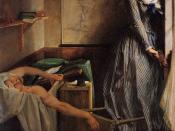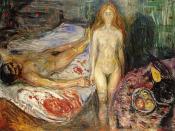The Green Room
'The Green Room' is the name Munch gave to a series of eight or so works painted in the later part of 1906 and in 1907. They are: 'Weeping Girl,' 'Zum Sussen Madel,' 'Desire,' 'Hatred,' 'Jealousy,' 'Consolation,' 'Cupid and Psyche' and 'The Murderess' motifs. The series is a cheerless combination of the Love, Anxiety and Death motifs in 'The Frieze of Life;' there is none of the rejoicing of love found in 'Eye in Eye' or 'The Dance of Life' nor is there the acceptance that the pain of love is part of the cycle of nature, as presented in 'Jealousy' or 'Woman in Three Stages.' Rather each painting has a bleak bitter view of love, presenting it in combination with anxiety and death, as a heartless, savage and brutal commodity. The series can be seen as the artistic result of Munch's personal decline. Since the Berlin Secession in 1902 Munch's abuse of alcohol had risen considerably, which had severely affected his nerves.
Increasingly critics had been praising his work and he was being invited to exhibit all over Europe, often alongside Cézanne and Matisse and other great masters of the time. With this artistic success came celebrity, eyes were always on Munch. When, in 1904, he attacked author Andreas Haukland in a restaurant as revenge for a drunken confrontation the night before it was widely reported throughout Scandinavia and in France and Germany. Similarly when the friendship with his 'pupil' Ludwig Karsten came to an abrupt end as a result of Munch making indecent advances to a woman, actions again fuelled by alcohol, it made the European press. Critics and the public had finally begun to respond positively to his work, and this response was undoubtedly helped by scandalous press reports, but the attention...



Fantastic essay,
accurate in relation to Munch's life, (http://www.munch.museum.no) analysis clearly written. The first authentically inspiring essay I've read on this site.
1 out of 1 people found this comment useful.